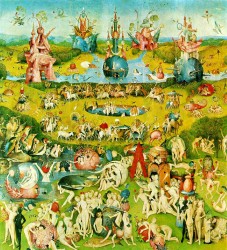
Gombrich 1967
“The Earliest Description of Bosch’s Garden of Delight” (E.H. Gombrich) 1967
[In: Journal of the Warburg and Courtauld Institutes, XXX (1967), pp. 403-406]
[Reprinted with some small adaptations in: E.H. Gombrich, Gombrich on the Renaissance. Volume 3: The Heritage of Apelles. Phaidon Press, London, 1993 (2) (1st edition: 1976), pp. 79-82]
[Also mentioned in Gibson 1983: 90 (E103 / E104)]
In this short article Gombrich refers to a passage in the travel journal of Antonio de Beatis who accompanied cardinal Luigi d’Aragona on his journey through Italy, Switzerland, Austria, Germany, the Netherlands and France in 1517-18. On 30th July 1517 the company visited the palace of Henry III of Nassau (at that moment Governor of the Netherlands) in Brussels. De Beatis describes a number of paintings that he could admire in the palace and one of these descriptions clearly seems to refer to Bosch’s Garden of Delights triptych.
Gombrich mentions that Otto Kurz has recently found convincing evidence for the fact that the Garden of Delights was confiscated by the Spaniards in the palace of William of Orange. This confirms the identification of the painting described by De Beatis because William was a later heir of Henry III. The link between Bosch and the counts of Nassau is not surprising at all, for the domains of the counts were mainly situated in Northern Brabant and their favourite residential town was Breda.
De Beatis’ text does not help us further when it comes down to an iconographical interpretation of the Garden of Delights, but according to Gombrich we can learn from it that international nobility appreciated Bosch’s work very early. Gombrich also mentions that Henry III was known to be fond of cruelties and gross humour: not an unimportant fact if we want to look at Bosch the way his patrons did. He adds that maybe the sexual element has been stressed too much when interpreting the Garden of Delights in the past and that too little attention has been paid to the theme of instability and impermanence that clearly pervades this painting.
Gombrich’s article was an important step forward in drawing up the pedigree of Bosch’s triptych. In his contribution to the scientific catalogue of the 1967 ’s-Hertogenbosch Bosch Exhibition Steppe also referred to the De Beatis passage (see Bijdragen 1967: 8/11). But Steppe had already published his discovery about the provenance of the Garden of Delights in Jaarboek Koninklijke Vlaamse Academie voor Wetenschappen, Letteren en Schone Kunsten van België, 1962, pp. 166-167 (as is also signalled in Lemmens/Taverne 1967-68: 71 (note 2).
[explicit]